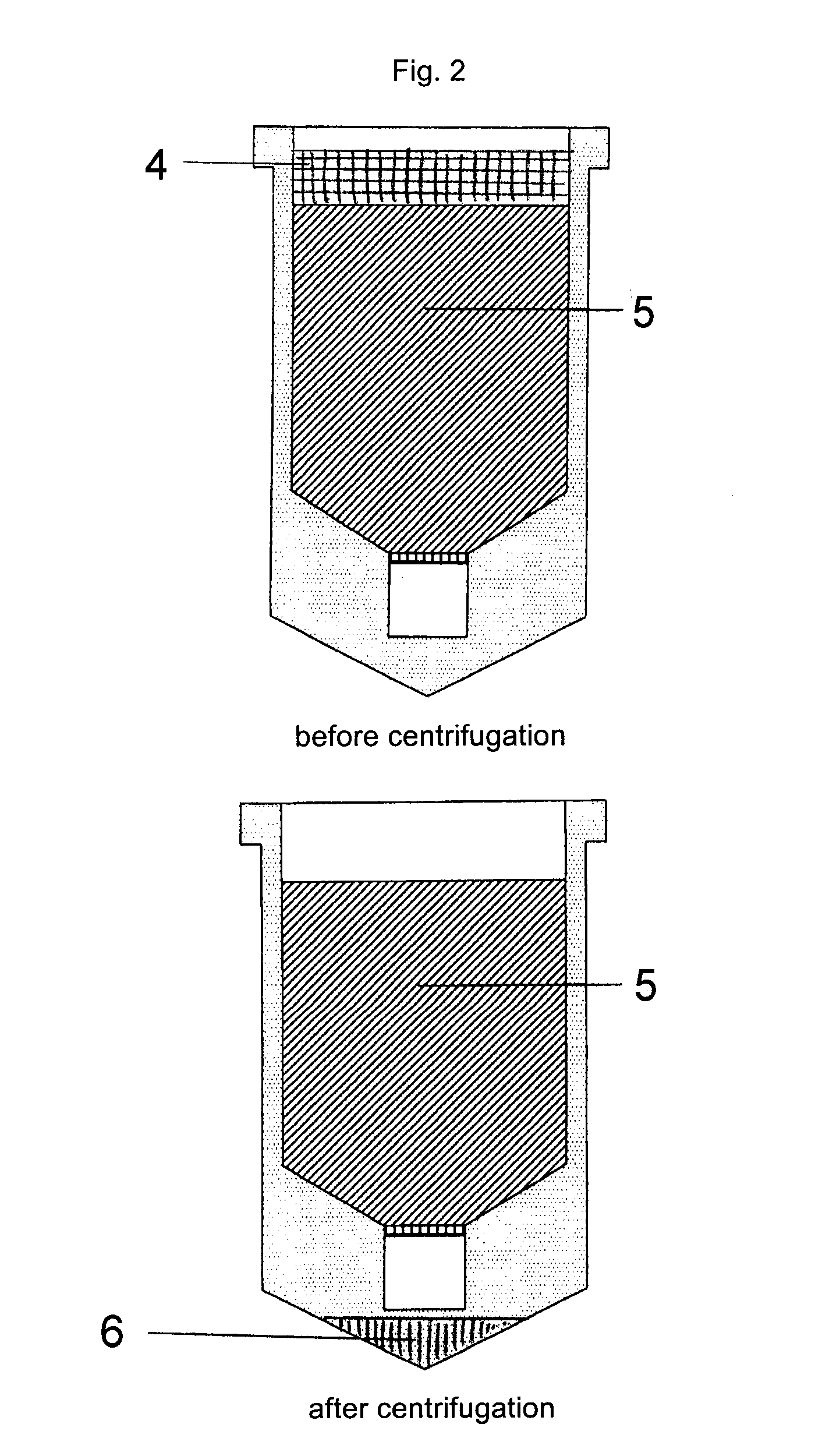Separation of an organic phase from a mixture comprising organic and aqueous phases by solid phase systems
a solid phase system and organic phase technology, applied in separation processes, filtration separation, instruments, etc., can solve the problems of difficult pipetting of phases, difficult separation of phases, and inability to avoid contamination of aqueous phases, so as to avoid pipetting or similar difficult preparation steps, the effect of simplifying extraction
- Summary
- Abstract
- Description
- Claims
- Application Information
AI Technical Summary
Benefits of technology
Problems solved by technology
Method used
Image
Examples
example 1
Phenol Binding Property of Poly(Vinylpolypyrrolidone)
[0033]Three spin columns were filled with different solid phase systems:[0034]column A: Sephadex G-10; GE Healthcare; Cat No. 17-0010-01[0035]column B: mixture of Sephadex G-10 and poly(vinylpolypyrrolidone); Sigma-Aldrich Co. Cat No. P6755[0036]column C: two layers of solids: poly(vinylpolypyrrolidone) (below); Sephadex G-10 (above)
[0037]On each of the columns A, B and C 200 μL of a mixture of 100 μL water and 100 μL phenol / chloroform was placed. The columns were centrifuged for 30 seconds with 6000 g.
[0038]Only in the case of column A with no poly(vinylpolypyrrolidone) being present there was still a two-phase system left after the centrifugation step.
[0039]This result shows, that poly(vinylpolypyrrolidone) polymer is suited for adsorption of organic phase like phenol / chloroform and Sephadex G-10 does not lead to a separation.
example 2
Extraction of Plasmid DNA and Subsequent Linearization by Restriction
Extraction:
[0040]5 μL pUC21-solution (5 μg pUC21), 10 μL 1M sodium chloride solution and 35 μL TE buffer (1 mM EDTA; 10 mM Tris; pH 7.5) were mixed with 50 μL phenol and 50 μL phenol / chloroform. The mixture was homogenized by vortexing and added to a spin column filled with adsorption medium, which was prepared by mixing the following components:
4 g Sephadex G-25; GE Healthcare; Cat No. 17-0032-01
1 g poly(vinylpolypyrrolidone)
1 g poly(ethylene-co-acrylic acid) sodium salt acrylic acid 5 wt.-%; Sigma-Aldrich Co. Cat No. 426733
in AE buffer (0.5 mM EDTA; 10 mM Tris; pH 9.0)
[0041]The column was centrifuged for 30 seconds with 6000 g.
Restriction:
[0042]A mixture of 25 μL of the column flow through, 4 μL 10×reaction buffer, 10 μL BiDest and 1 μL enzyme (1. BamHI; 2. HindIII; 3. Sau3A) was heated for 60 minutes at 37° C. in a water bath.
[0043]The results showed that after separation of the plasmid DNA the same could be lin...
example 3
Extraction of Linearized Plasmid DNA and Subsequent Ligation
Extraction:
[0044]50 μL linearized pUC21-solution (Example 2) were mixed with 50 μL phenol / chloroform. The mixture was homogenized by vortexing and added to a spin column filled with adsorption medium, which was prepared by mixing the following components:
6 g Sephadex G-10
2 g poly(vinylpolypyrrolidone)
in AE buffer
[0045]The column was centrifuged for 30 seconds with 6000 g.
[0046]A mixture of 30 μL of the column flow through, 4 μL 10×reaction buffer, 5 μL BiDest and 1 μL T4 DNA ligase was kept for 150 minutes at room temperature.
[0047]The result showed, that after the separation the linearized plasmide DNA could be modified by ligation and a potential rest amount of phenol has got no influence on the enzymatic reaction of a ligation.
PUM
| Property | Measurement | Unit |
|---|---|---|
| volumes | aaaaa | aaaaa |
| volume | aaaaa | aaaaa |
| volumes | aaaaa | aaaaa |
Abstract
Description
Claims
Application Information
 Login to View More
Login to View More - R&D
- Intellectual Property
- Life Sciences
- Materials
- Tech Scout
- Unparalleled Data Quality
- Higher Quality Content
- 60% Fewer Hallucinations
Browse by: Latest US Patents, China's latest patents, Technical Efficacy Thesaurus, Application Domain, Technology Topic, Popular Technical Reports.
© 2025 PatSnap. All rights reserved.Legal|Privacy policy|Modern Slavery Act Transparency Statement|Sitemap|About US| Contact US: help@patsnap.com



